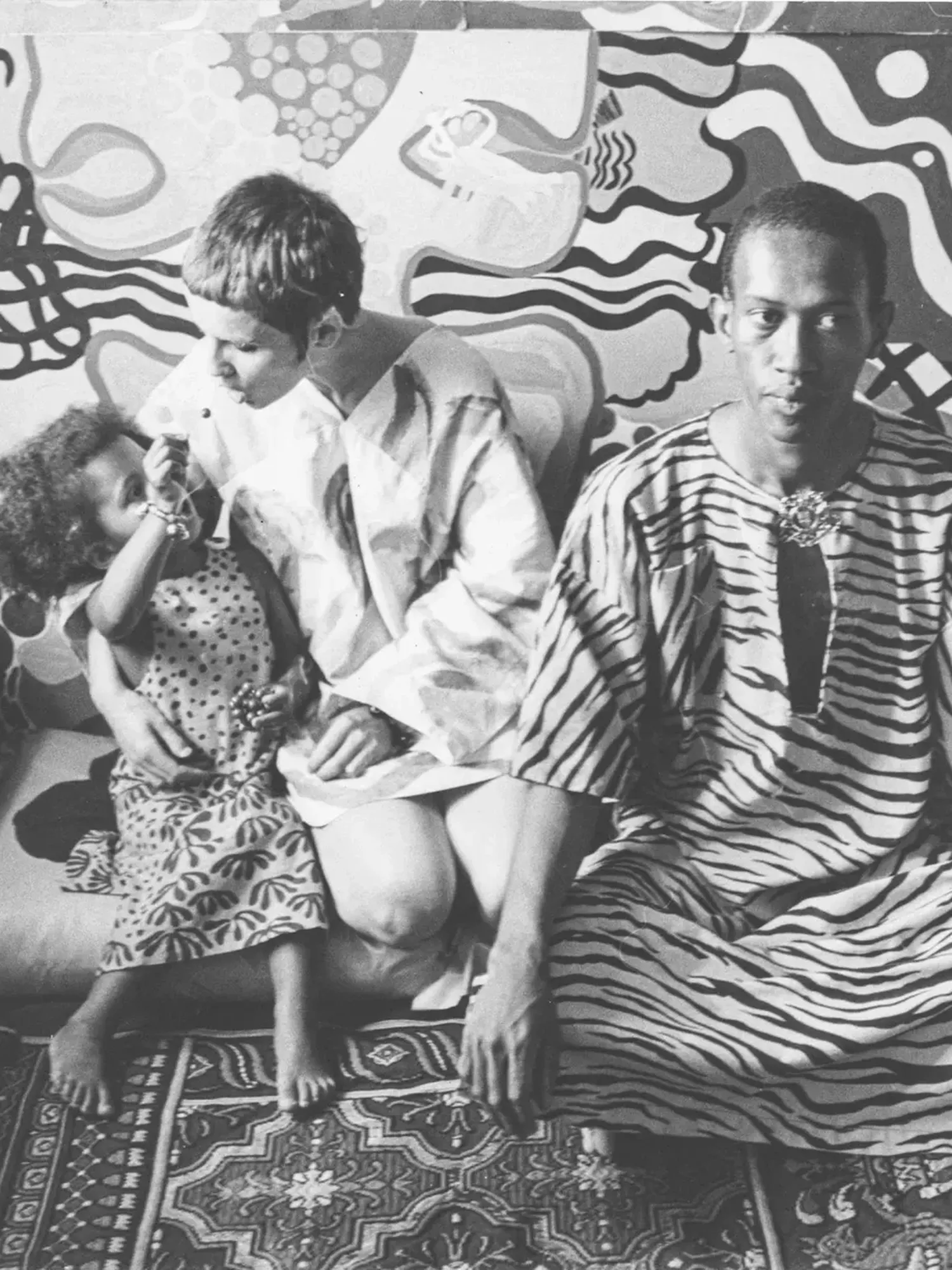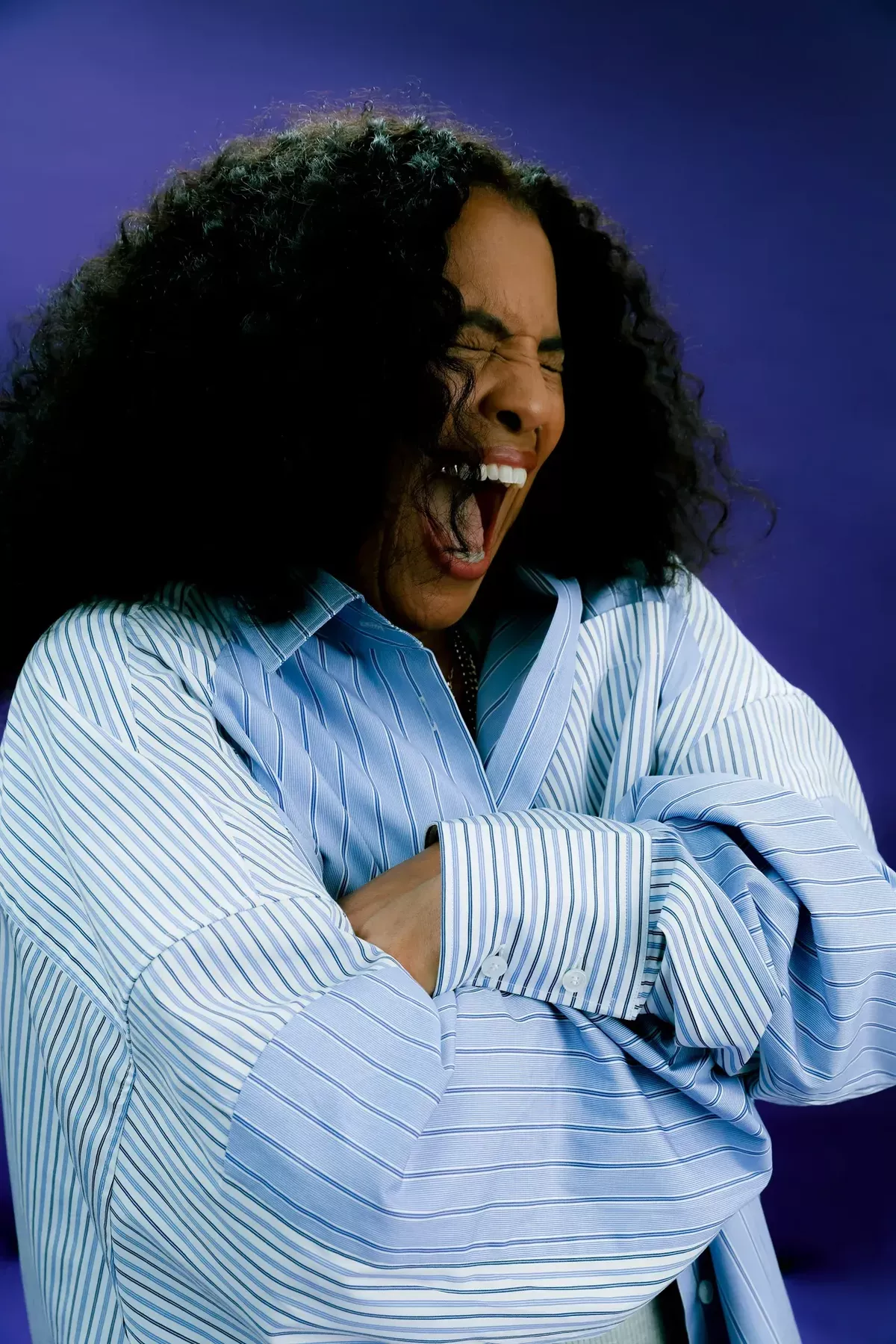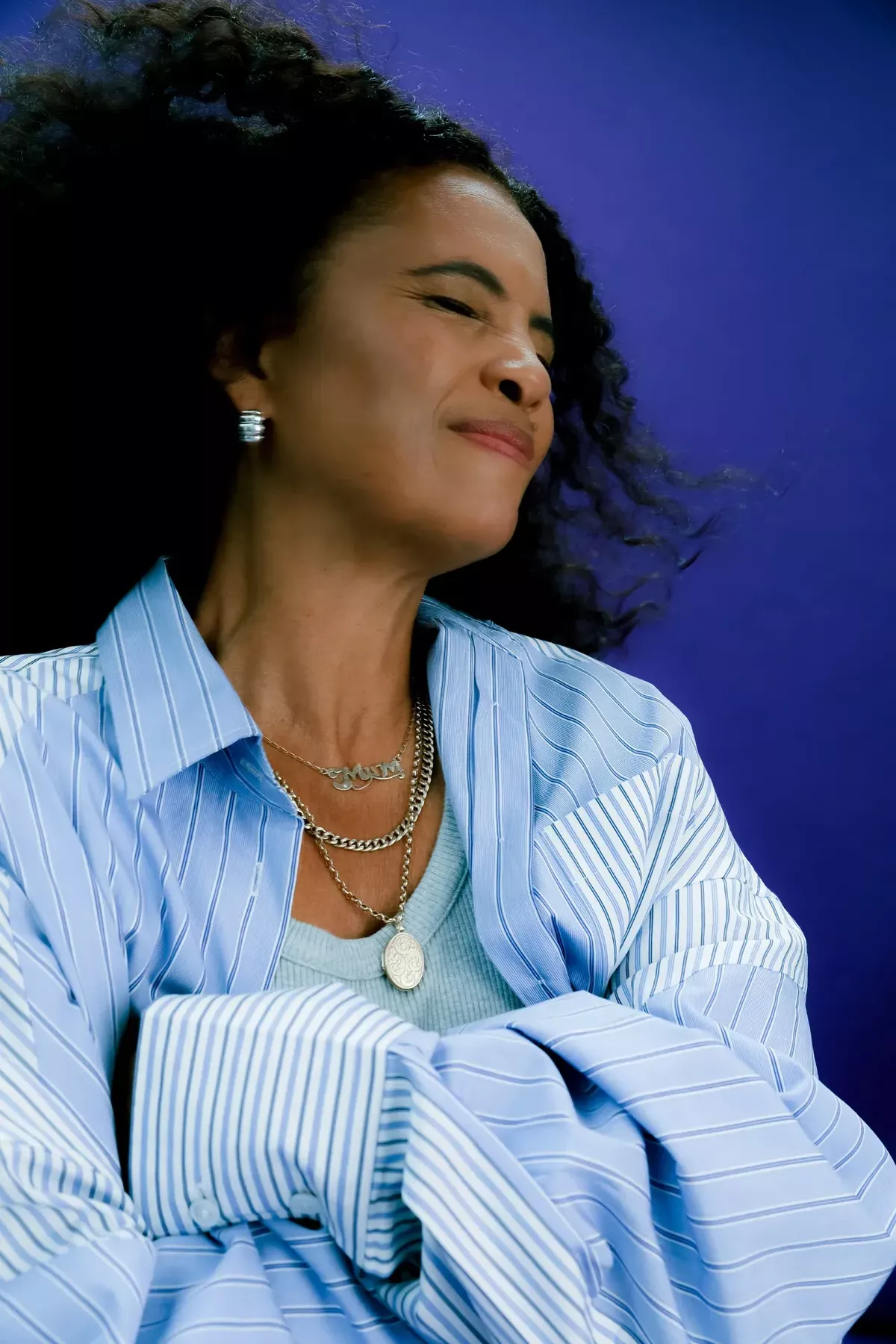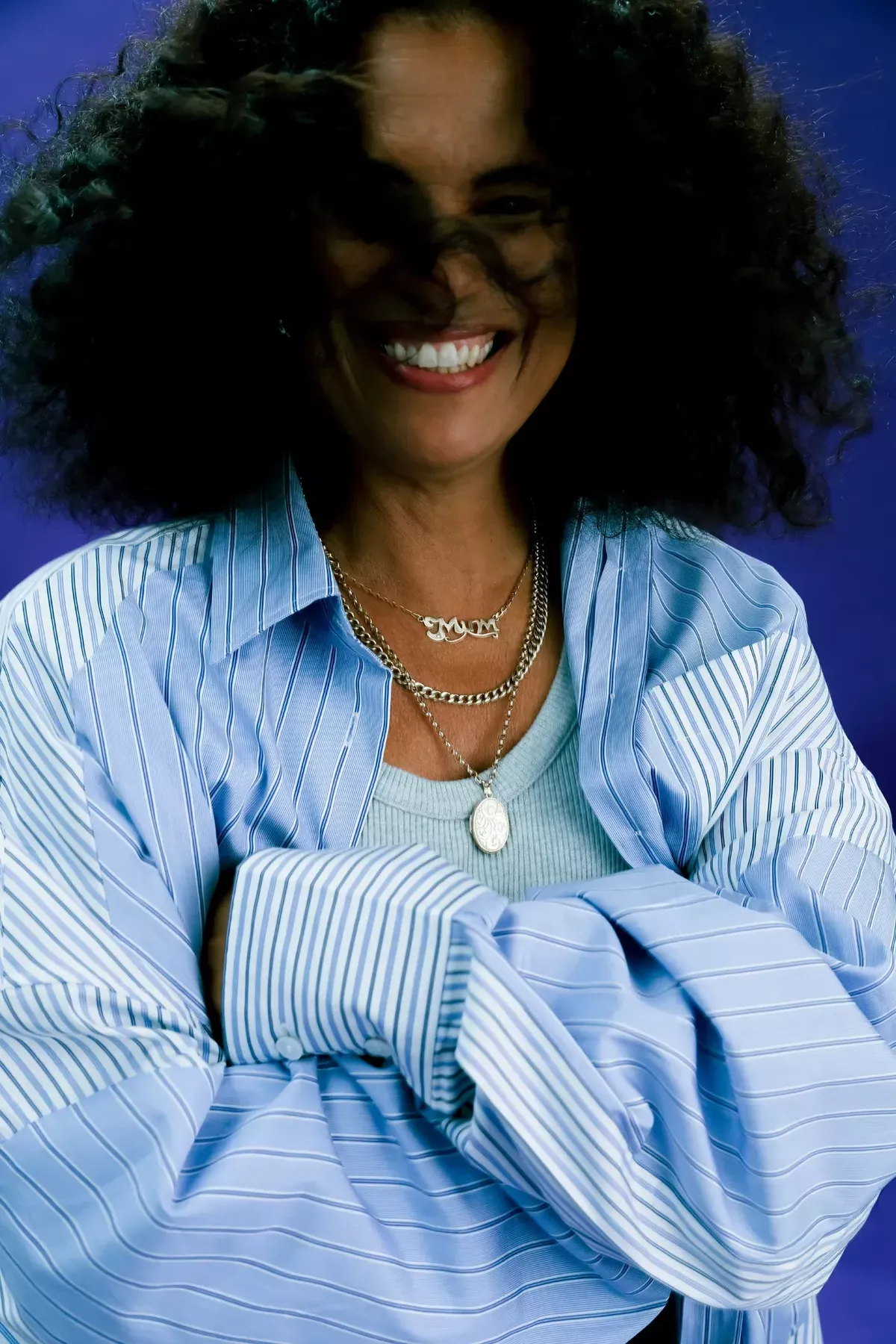For globe-trotting, chart-topping star Neneh Cherry, music, fashion and family continue to shape an extraordinary life, as her upcoming memoir A Thousand Threads reveals
My daughters and I keep talking about threads – all the invisible strings that connect the tapestry of your life. That’s where the name of my upcoming memoir, A Thousand Threads, came from; while I was writing it, I could see my life as a multitude of different strands, all tied together.
In 60 years, so much has happened that there’s probably another thousand that didn’t make it into the book: Lou Reed sending my brother and I in a limousine to pick up the mouthpiece to my dad’s trumpet (we made it back just in time for their show); dancing with Prince and feeling like a giant because he was so small and slick and I was in huge trainers trying to keep up; listening to the radio on a peaceful Thanksgiving morning in Long Island until the house a few blocks down got blown up by mobsters. Part of me mourns the things that aren’t in there, but there’s a rhythm to telling a story, like a song. Maybe I’ll do something else with the scraps.
That’s what my Swedish mother, Moki Cherry, did. As an artist and designer, throughout her life she would make amazing clothes or art, sometimes out of discarded fabric she found in skips. She was always ahead of her time – I still feel like the world is catching up. Likely one of the first women in the world to wear a mini skirt, in her youth she cut her hair and stepped out in her own micro maroon leather creation around 1962. (A stranger she’d never met, some guy in Stockholm, tried to beat her up because he was so angry about it.) She was inspired by the fabrics and clothes from across a galaxy of communities and would translate them into her own intuitive style: dresses on top of harem pants; a string of handmade glass beads she would wear wrapped twice around her very short hair.

Neneh Cherry as a child with her parents in Stockholm, Sweden. Photo: Peder Bjorkegren, Courtesy of Estate of Moki Cherry

Photo: Peder Bjorkegren, Courtesy of Estate of Moki Cherry
Both my parents wore wild stuff. There are great photographs of my stepfather – my dad – jazz musician Don Cherry, in one of those baseball caps with a propeller, knickerbocker trousers, leather jacket, high socks and shoes. Living in Skåne, on the southern coast of Sweden, my brother and I would really go through it going out with them. We hated the way people would stare at us. They’d see the clothes and think they were really weird.
As a child, Moki made me a long gown with a flowery panel, or these puffy-sleeved crochet dresses I still have, but going to school in the small town of Tågarp in the 1970s, on the cusp of teenage-hood, I just wanted to look like everyone else. I had a real bee in my bonnet about having clothes like the other kids wore, but we wouldn’t get them because they were “too expensive” or “I didn’t need them”. Occasionally, my grandmother on my mum’s side used to take mercy on me and buy me normal clothes: flared jeans and platform clogs (ie, the “right” jeans, the “right” shoes… or so I thought back then).
We had always commuted between Sweden and New York, staying in the Chelsea Hotel or sublets when we were there, but when I was around 13 we got our first permanent home, a loft in Queens. I didn’t go to school. I had begged not to. By this time, we had moved around so often for my parents’ music tours and art shows that nothing about our life was traditional. Although my bohemian upbringing still placed great value on lifelong learning, I had to plead with them to take a break from studying. Eventually, they relented and… I never went back.
The coolest people to me are the ones I see on the street with a trouser leg tucked into a sock or a hat with a scarf underneath – it’s the personality they bring.
Neneh Cherry
I feel like I’m now ready to return – I’d like to study literature or creative writing – but back then I got a job as a nanny for some family friends instead. Now I had the money to buy my own clothes. This woman had me mixing cleaning products with bleach to scrub her floor; I remember my hands smelled of popcorn. It nearly killed me, but I bought a straight-cut double-breasted blue coat with that money. I loved that coat.
This was back in the days when I used to step out in maroon lipstick with pink hair rollers still in, homegirl style, until the following year when my mother took me to London and I first encountered punk. Suddenly, I was all about second-hand leopard-print – a shirt and a fake-fur jacket – which I’d pair with a kilt or army trousers and an army boot, mostly bought from New York thrift shops on Canal Street, or a long leather coat over a pink shirt and black skirt. Sometimes I wore a tie. I’ve always searched for my tribe, wanting to be a part of something, but never wanting to disappear. (I think, ultimately, I’d find it in multicultural Buffalo style, through Ray Petri, as much a proud attitude as it is an often bomber-jacketed look.)
After a trip through West Africa to visit Sierra Leone, the homeland of my birth father, musician Ahmadu Jah, I returned to London with Don more appreciative of its mix. We’d have Black sound system culture or post punk, and in clubs in the West End they would all meet. It was a melting pot that didn’t dilute any one culture. I felt part of that motley community, instead of feeling like I had to fit into one style. I was coming to terms with the fact that I’m made of so many different parts.

Cotton shirt, Stella McCartney. Ribbed organic-cotton vest, Toteme. Earrings, Mejuri. Necklaces, Neneh’s own. Photo: Delali Ayivi

Photo: Delali Ayivi
That new expression started out more Rasta. I was wearing head wraps with pleated skirts and flats, a kind of militant look in khakis or cardigans with suede fronts. I started to sing on stage with post-punk band The Slits, encouraged by its late, legendary frontwoman, Ari Up, who would borrow the dresses I’d made in West Africa. Back then no one would say she, as a white woman, was stealing from the culture. She’d be in dreadlocks, arguing with Twelve Tribes guys and they’d say, “Yeah, she’s a German Rasta. It’s cool, man.” There’s never going to be anyone else like her.
It was on The Slits tour bus that I met their drummer, Bruce Smith, who also performed with The Pop Group. Later, he and his Pop Group bandmates would ask me to join as the singer for their new group, Rip Rig & Panic. Bruce and I would marry when I was 17 and six months later I fell pregnant with Naima. It felt natural. We were making families anyway, in our alternative way, and living in England on my own, at heart I think I wanted to make deeper roots. People always talk about me performing while pregnant with my second daughter, Tyson, on Top of the Pops, but years before that, seven months into expecting my first, I was rolling around the stage at Womad festival, wearing white lace.
In 1988 I went solo and started working with stylist and designer Judy Blame around the video for my breakthrough song, 'Buffalo Stanceä. We had an antifashion mentality. Rather than being fashion victims by letting the clothes dictate what we were saying, we were going to take clothes into our world and mash them up a bit. Judy and I would pull clothes from designers – Rifat Ozbek, WilliWear and Johnny Was – to mix with fake gold and trainers. We used to go to Azzedine Alaïa in Paris and I’d walk out weighed down. Judy would be like, “He doesn’t even give this many clothes to Tina Turner!” But even in a Jean Paul Gaultier or Alaïa dress, I’d be wearing Air Jordans. A bit later, my kids and I gave my fashion mode a name, inventing this “Raggy-O” character: she’d wear something quite classic and chic, then fuck it up – leggings from Dalston with Chanel shoes.
The tragedy is that boxes and boxes of these clothes went missing somewhere. I still have some bras from Gaultier, a white faux-fur coat by Alaïa, but the handful of pieces left I’ve given to my musician daughter, Mabel. She’s the only one who fits them. I get to keep the memories forever, though – like when Azzedine insisted on flying to London to sew me into my wedding robe to marry musician and producer Cameron McVey (Bruce and I split up in 1984), who I’m still with 34 years later. Short and sleeveless, he had made it a stretchy dress that ended just above shorts made of the same pastel blue ribbed silk with cream polka dots, which he paired with a deep-blue sheer netted jacket with silver beading by Monsieur Lesage. The heels were Manolo Blahnik.
The coolest people to me are the ones I see on the street with a trouser leg tucked into a sock or a hat with a scarf underneath – it’s the personality they bring. I’ve always liked the duality of being boisterous and feminine, feeling womanly in something boyish. There was a long time when a Kangol hat was the perfect last touch. I’d put it on high, tilted to the side, then the rest could be girly.
My wardrobe is a bit random now. More classic and sporty, but I’m not buying a lot. Even though I hate any ageism, certain things just feel too young on my body. A T-shirt and Bottega Veneta tuxedo trousers is more my speed at 60. Some days, a long dress. I love designers such as Grace Wales Bonner, Kim Jones and Martine Rose. Martine’s like a sister – as soon as I met her, it felt like I knew her.
All of my kids make music, but they aren’t walking in my footsteps, they’re making their own. It’s a language that is very personal. Even when you’re creating these amazing pop records, like in Mabel’s case, it’s about leading with heart that gives music its soul. I never pushed my children into music, but since they ended up going that way I try to help them stay on course. Sometimes this music business is going to knock you hard, I tell them. You’re going to feel it. But don’t give up.
Sometimes I look at pictures from 20 years ago and think, 'What the hell was I wearing?' But it’s a style, it’s a thing, it’s a reflection of whatever is happening around you, it’s your journey in life.
Neneh Cherry

Photo: Delali Ayivi

Photo: Delali Ayivi
People are louder than ever. There is a pressure to look a certain way, there’s commentary on our bodies and it’s a lot to navigate. Social media didn’t exist until pretty recently. We used to have to go to places to find people because they didn’t have a telephone at home. “Oh, he’ll probably be in that club or at that night, I’m just gonna go.” But while so much is different, much is the same. At the end of the day, you’re making music, or clothes, or a living – creativity is eternal. And I repeat to my kids what my dad always said: “Don’t let them change you.” Staying with your own rhythm and sound is so important.
My nostalgia isn’t so much for a time but for a feeling, say: Notting Hill Carnival, at the Rapattack sound system, and they’re playing The Gap Band’s “Outstanding”. Me and my sister (in spirit), Andi Oliver, in our short suits. Naima in the buggy. Some guy and his dog. Every time I hear that Gap Band tune it takes me right there. How monumental that moment was, without us realising a thing. Being young and so full of spirit… I’m still full of spirit, but it’s a different energy. Back in those days, Andi and I would meet to just lie on the sofa together. While we’re still incredibly close, now she lives on the other side of town. We have to look at our calendars to figure it out.
But so much of the change is good. When I walked into my Vogue photoshoot, I saw all these beautiful young Black women, brown women – all those women! The photographer, the stylist, the assistants… It made me so happy. We’re no longer hesitant to discuss race, gender, trauma, mental health. It’s how things should be.
Sometimes I look at pictures from 20 years ago and think, “What the hell was I wearing?” But it’s a style, it’s a thing, it’s a reflection of whatever is happening around you, it’s your journey in life. Naima is 41 now and sometimes wears a coat that my mother made for Don. While it looks great on her, I’d never wear it. But the more I grow, the more I appreciate my parents’ ways. They sought to create change through how they dressed, how they lived, how they sounded, all the music or art that they made – they were lives dedicated to self-expression. The way I wear clothes is the same, forever connected to where I am, to how I feel.
A Thousand Threads by Neneh Cherry (Fern Press, £25) is published on 3 October
As told to Amel Mukhtar. Cover look: Knotted viscose shirt and trousers, Bottega Veneta. Leather mules, Tod’s. Silver hoop earrings, Mejuri. Rings, Neneh’s own. Hair: Danielle Igor. Make-up: Grace Sinnott. Nails: Trish Lomax. Set design: Jade Adeyemi. Production: Chloé Medley. Photographs: Delali Ayivi. Styling: Honey Sweet Elias
